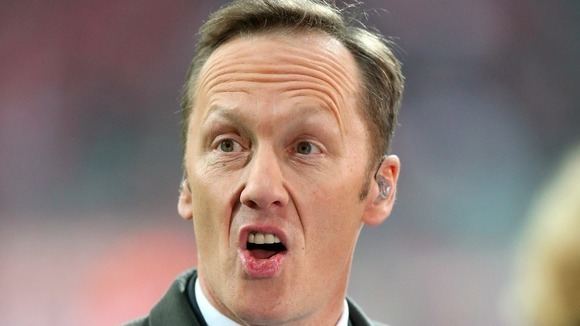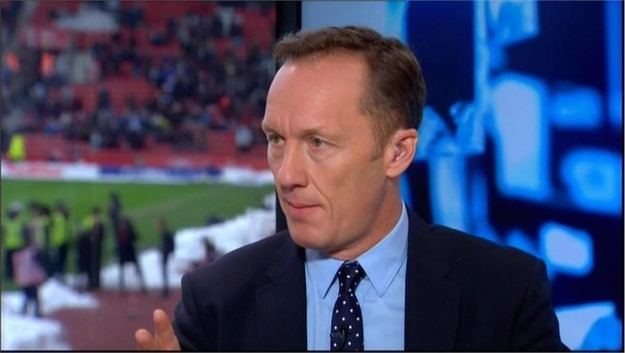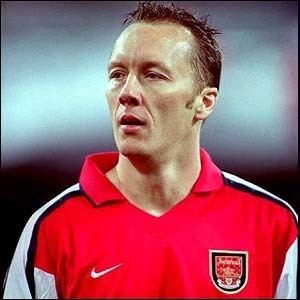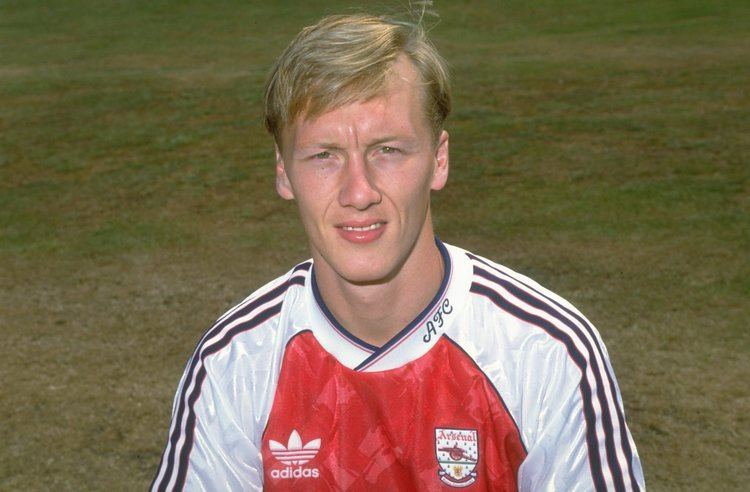Full name Lee Michael Dixon Spouse Yolande Dixon Name Lee Dixon | Role Footballer Years Team Height 1.78 m | |
 | ||
Date of birth (1964-03-17) 17 March 1964 (age 51) Similar People Profiles | ||
Ian wright winding up lee dixon original
Lee Michael Dixon (born 17 March 1964) is an English retired professional footballer who played as a right-back for Arsenal, Burnley, Bury, Chester City and Stoke City as well as the England national team.
Contents
- Ian wright winding up lee dixon original
- Lee dixon football blooper
- Early career
- Arsenal
- International career
- After football
- Career statistics
- References

A childhood Manchester City fan, Dixon began his footballing career as a youth at Burnley, making his professional debut for them in 1982. From there he played for Chester City and Bury before joining Stoke City in 1986 for a fee of £50,000. He instantly impressed at Stoke and forged a fine defensive partnership with Steve Bould. The pair's potential and performances attracted the attention of Arsenal and in January 1988 they both joined the "Gunners" for a combined fee of £765,000.

The following season, as Dixon cemented his place in the team, Arsenal won their first league title in eighteen years in a dramatic final game of the season. A defensive mainstay in a successful Arsenal team until his retirement in 2002, Dixon's tenure at Arsenal saw him collect four league championship medals, three FA Cup winner's medals and a UEFA Cup Winners' Cup medal. He was named in the PFA Team of the Year twice, for the seasons 1989–90 and 1990–91. His retirement came at the end of Arsenal's domestic double-winning 2001–02 season, their second in his time at the club. At the time of his retirement, he had played at 91 out of the 92 Football League grounds – every one except Fulham's Craven Cottage.

At international level, Dixon was capped 22 times for England, scoring once.

Since his playing retirement, Dixon has worked as a football pundit and columnist. He began his television career working for the BBC, primarily on their Match of the Day and Football Focus programmes, then moved to ITV Sport in July 2012. Starting in 2013, he provides commentary alongside Arlo White for NBC's Premier League coverage in the USA. He has also done charitable work, joining Lawrence Dallaglio in a sponsored bike ride for Sport Relief which raised over £986,000 for the charity.
Lee dixon football blooper
Early career
Dixon was a boyhood Manchester City supporter. He began his professional playing career in the lower divisions. On leaving school in 1980, he joined Burnley as an apprentice in 1980, turning professional in 1982, then signed for Chester City (where he experienced finishing bottom of the whole Football League in 1983–84), Bury and later Stoke City. At the Victoria Ground Dixon made a fine impression with some fine performances from right back as he played in 50 matches in 1986–87 scoring three goals. In 1987–88 Dixon made 38 appearances scoring twice. He joined First Division Arsenal in January 1988 for a fee of £375,000 and was later joined at Highbury by Stoke teammate Steve Bould.
Arsenal
Dixon was signed by Arsenal boss George Graham in January 1988 following the departure of England right back, Viv Anderson, to Manchester United. This was the first time that Dixon had played in the First Division.
It took a while for Dixon to be given a first team role at Highbury. With England international Kenny Sansom at left back, the equally left-sided Nigel Winterburn had been a guarded success in the unfamiliar right back role, though Dixon did make his debut against Luton Town in February 1988 and played six times in total before the season ended. In the new season, Winterburn moved across to left back, allowing Dixon to take over the No.2 shirt, which he duly did for well over ten years. Displaced Sansom left Arsenal the following winter.
Dixon later wrote in his column in The Independent of the defence that he played in at Arsenal, "I was fortunate to play in an Arsenal back line that earned itself a reputation as being OK. I'm not trying to be overly modest in saying that, as individuals, we weren't the best players in the world. But certainly all my weaknesses were compensated for by Tony Adams, Nigel Winterburn, Martin Keown and Steve Bould, and vice versa. If one of us wasn't playing well, the others picked up the slack."
Dixon and Winterburn made the full back positions their own for the next decade or so, while captain Tony Adams and the long-serving David O'Leary operated in the middle. Later in 1988 they were joined by Steve Bould who, like Dixon before him, had been spotted by Graham playing for Stoke City. These five defenders, often playing as a back five together (rather than the conventional back four) were the linchpin of an Arsenal side who became serious challengers for the First Division title the 1988–89 season, an honour which they had not won since 1971 but had looked more and more like winning since Graham's appointment as Arsenal manager in May 1986.
Dixon was a marauding right back, ever willing to support his winger David Rocastle and his attacking skills were still noted even though his main job (and the main priority of the side as a whole) was to defend. He also had a short spell during this period as the club's penalty taker. Arsenal took the chase for the League championship to the last day of the season when they faced Liverpool at Anfield. With Arsenal needing to win by two goals, the game stood at 1–0 as the clock showed the 90 minutes were up. Dixon received a ball in his own half and looked to mount a final attack. Spotting the run of centre forward Alan Smith towards the right channel, Dixon delivered a long ball on to his chest. Smith's run had forced a Liverpool defender across with him and Arsenal midfielder Michael Thomas made a charge into the gap, took Smith's sideways pass in his stride and slipped the ball past Bruce Grobbelaar. There was barely time for Liverpool to restart and Arsenal took the title, the first of many honours Dixon would win.
Arsenal struggled to hold on to the title the following year (and were unable to take part in the European Cup because the ban on English clubs after Heysel was still ongoing). In the 1990–91 season, Arsenal's defence (now with David Seaman playing behind them in goal) grew even meaner, with just one defeat all season as they won the League championship again. After the 1992 summer, a fit-again Dixon was also defending the League title within the familiar Arsenal defence. With O'Leary's retirement imminent, Graham had provided extra cover in the centre of defence by signing Martin Keown from Everton – ironically the player who'd ended up playing at right back in Euro 92 after both Dixon and Stevens became unavailable. O'Leary ended up in Dixon's place at right back for the 1993 League Cup final against Sheffield Wednesday – Dixon was suspended, having been sent off in Arsenal's FA Cup semi-final victory over Spurs. Arsenal won 2–1. Dixon was back when the sides met again for the FA Cup final which Arsenal won by the same scoreline in a replay, after the initial game had ended in a 1–1 draw.
In 1994, Dixon won a European medal to complement his domestic collection as Dixon, Winterburn, Bould and Adams suppressed the efforts of Tomas Brolin, Gianfranco Zola and Faustino Asprilla of Italian side Parma. Arsenal scored an early goal in the European Cup Winners Cup final in Copenhagen and this was enough, winning 1–0. Dixon was again in his No.2 shirt as Arsenal slumped domestically in 1995 but reached the final of the Cup Winners Cup again. Though the defence in Paris was breached by Real Zaragoza, Arsenal equalised and took the game to extra time. A lob from 40 yards in the final minute from Nayim (an ex-Spurs player) over David Seaman prised the trophy from the Gunners.
At the end of 1996, Arsène Wenger arrived at Highbury and started to introduce lifestyle policies to the Arsenal squad, changing their life's outlook, self-awareness and diet. Wenger later admitted that he expected to replace each defender he inherited fairly quickly, but just as quickly realised he didn't need to. Dixon and his defensive colleagues recognised Wenger for giving them extra years at the helm of the game. Arsenal won the second "double" of the club's history in 1998 and Dixon received a testimonial the following year as he entered his tenth full season at Arsenal.
Dixon played in a UEFA Cup campaign in 2000 which saw Arsenal reach the final in the same Copenhagen stadium where they had won the Cup Winners Cup six years earlier. This time they were beaten on penalties by Galatasaray of Turkey. Earlier in that season he had missed a penalty in a shootout as Arsenal crashed out of the 1999/2000 FA Cup to Leicester City. The following year Arsenal reached the FA Cup final but lost 2–1 to Liverpool at the Millennium Stadium in Cardiff – the 37-year-old Dixon being outpaced by the 21-year-old Michael Owen for the winning goal. Dixon played on for one more season helping Arsenal to win another historic "double", the third in the club's history and second under manager Arsène Wenger, clinching the league title over rivals Manchester United at their home ground Old Trafford. This made him one of the few men to have won league titles in three different decades (1980s, 1990s and 2000s).
Dixon retired from playing after winning that double in 2002 at the age of 38, with Adams quitting at the same time. Only Seaman and Keown then remained at the club from the defensive group Dixon had become associated with at Arsenal (after O'Leary's retirement in 1993, Bould had been the next to go in 1999 and then Winterburn followed him out of Highbury a year later). Dixon made 458 appearances in the League, scoring 25 goals.
International career
Dixon made his England début in April 1990 in a World Cup warm-up game against Czechoslovakia. He played well, but there was little hope of him being in the squad for the tournament as he was at least third in the pecking order behind Gary Stevens and Paul Parker. Only injury to one of these two would have opened a door for Dixon to go to Italy and that didn't happen as the pair stayed fully fit for the length of the tournament. After the World Cup, new manager Graham Taylor instantly replaced Stevens and Parker with Dixon, who scored a goal at Wembley in his sixth international in an important Euro 92 qualifier against the Republic of Ireland. The game ended 1–1.
By the end of 1991, Dixon had played in eleven internationals, including all of the Euro 92 qualifiers, through which England qualified for the finals in Sweden. As the finals approached, Dixon suffered an injury, allowing Stevens a route back into the side as the deadline for squad announcement approached. Taylor duly named Dixon instead of Stevens in his provisional squad, but ultimately neither went to the tournament. Dixon pulled out through an injury suffered in an accident at home so Stevens was recalled, only for the Rangers full back also to withdraw through injury. England ended up with no recognised right back in their squad and didn't get past the group stages.
1993 did not go well internationally, with England failing to qualify for the 1994 World Cup in the United States. Dixon's 21st cap, in a 7–1 win over San Marino in the final qualifier (a result which was immaterial) seemed to be his last as Taylor quit as manager and Terry Venables took over, experimenting with other right backs until installing Gary Neville in the spot in 1995, a role he maintained until 2006.
In late January 1999, caretaker England manager Howard Wilkinson recalled Dixon to the England squad more than five years after his last appearance, and he took to the field on 10 February in a 2–0 defeat by France. His international career ended with 22 caps in total but he did not play in a major tournament.
After football
In retirement, Dixon has concentrated on several business interests including the Riverside Brasserie in Bray, Berkshire, originally with his friend Heston Blumenthal. He also worked as a regular pundit for the BBC on Match of the Day 2 as well as appearing on Score, and Football Focus before leaving the BBC to join ITV Sport in July 2012. At ITV he formed a great relationship with pundit and former player Roy Keane.
In 2010, he became "completely hooked" on cycling, and goes riding two or three times a week, after Lawrence Dallaglio persuaded him to take part in the 'Dallaglio Cycle Slam' during the Six Nations Championship in February that year, raising money for Sport Relief. They raised over £986,000 for the charity.
In July 2012, Dixon announced he was leaving the BBC and joining ITV as a pundit to work alongside his friend Adrian Chiles.
From 2013, he has been the co-lead commentator with Graeme Le Saux for the Premier League on NBC Sports, working alongside Arlo White. He's also contributed to the network's Premier League Download program.
